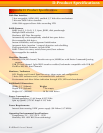
RAIDBank5 Owner’s Manual
44
Read Ahead Cache Motivated by the principle of “spatial locality”, many RAID controllers
read blocks of data from secondary storage ahead of time, i.e., before an application actually
requests those blocks. The number of data blocks that are read ahead of time is typically
governed by some heuristic that observes the pattern of requests. The read-ahead technique
is particularly efficient when the spatial distribution of an application’s requests follows a
sequential pattern.
Read Through Cache Using this methodology, a read operation not only reads data from
secondary storage into system memory but also places the data into the cache such that future
need for the same data can be addressed expeditiously by directing a read operation for that
data into the cache only.
RAID Rebuild When a RAID array enters into a degraded mode, it is advisable to rebuild the
array and return it to its original configuration (in terms of the number and state of working
disks) to ensure against operation in degraded mode
SATA Acronym for “Serial ATA”. A hard disk drive interface standard developed to enhance
connectivity and speed over the IDE, or Parallel ATA disk interface. Current generation SATAII
supports speeds up to 300MB/S.
Stripe A stripe is a logical space that spans across multiple hard disks with each constituent
hard disk contributing equal strips (or chunks) of space to the stripe. In the figure below,
strips 1, 2, and 3 from hard disk 1, 2, and 3 respectively comprise a (purple colored) stripe.
Synonym: major stripe
Stripe Set A stripe set is a set of stripes that spans across multiple hard disks. In the figure
below, the displayed stripe set has 4 stripes, with strip number 1 comprised of the purple
strips 1A, 1B and 1C. Stripe number 2 is comprised of the green strips 2A, 2B and 2C etc.
Stripe Size This is the size of the strips that constitute each stripe. This term is a misnomer –
though prevalent – since it should appropriately be called strip size or chunk size.
TCP/IP This is an acronym for “Transmission Control Protocol/Internet Protocol”. It is
comprised of two parts TCP and IP. The former, i.e., TCP is a peer-to-peer connection oriented
protocol that guarantees the delivery of data packets in the correct sequence between two
peers. The latter, i.e., IP is the protocol that defines and governs addressing, fragmentation,
reassembly and time-to-live parameters for packets.
Universal Serial Bus (USB) is a specification created in 1996 by a consortium of companies
led by Intel to simplify the connection between host computer and peripheral devices. The
original USB 1.x specification was capable of 12 Mbit/sec. USB 2.0 is the most common port
at time of publication, and is capable of 480Mbit/sec gross bandwidth. USB 3.0 was ratified
in November of 2008, and is capable of 5Gbit/sec gross bandwidth.
Volume Set A volume set is a concatenation of storage elements that may be RAID arrays,
JBODs, or simply areas of disks that are not part of RAID arrays.
C-Glossary


















